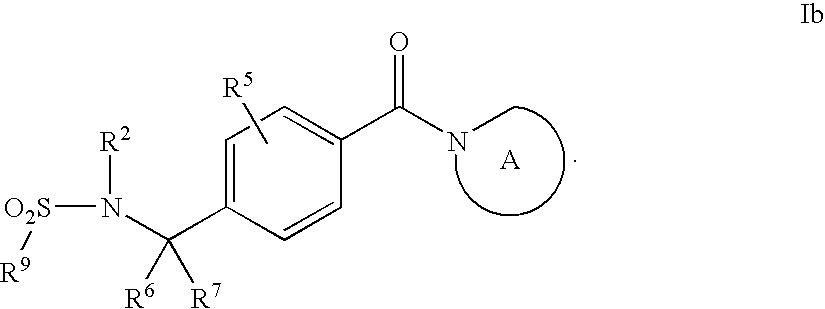Pharmaceutical use of substituted amides
a technology of substituted amides and amides, which is applied in the direction of immunological disorders, metabolism disorders, extracellular fluid disorders, etc., can solve the problems of increased mortality of cardiovascular diseases, major global health problems, and metabolic syndrom
- Summary
- Abstract
- Description
- Claims
- Application Information
AI Technical Summary
Problems solved by technology
Method used
Image
Examples
examples
Compounds of General Formula (I)
[0707]The following examples and general procedures refer to intermediate compounds and final products for general formula (I) identified in the specification and in the synthesis schemes. The preparation of the compounds of general formula (I) of the present invention is described in detail using the following examples. Occasionally, the reaction may not be applicable as described to each compound included within the disclosed scope of the invention. The compounds for which this occurs will be readily recognised by those skilled in the art. In these cases the reactions can be successfully performed by conventional modifications known to those skilled in the art, which is, by appropriate protection of interfering groups, by changing to other conventional reagents, or by routine modification of reaction conditions. Alternatively, other reactions disclosed herein or otherwise conventional will be applicable to the preparation of the corresponding compou...
specific examples
Example 1-1
General Procedure (A)
N-Methyl-N-[4-(1,3,3-trimethyl-6-aza-bicyclo[3.2.1]octane-6-carbonyl)-benzyl]-acetamide
[0746]
Step A
[4-(1,3,3-Trimethyl-6-aza-bicyclo[3.2.1]octane-6-carbonyl)-benzyl]-carbamic Acid Tert-butyl Ester
[0747]
[0748]To a solution of 4-(tert-butoxycarbonylamino-methyl)-benzoic acid (15.0 g, 59.69 mmol) in THF (200 mL) was added with stirring HOBt (8.87 g, 65.66 mmol) followed by EDAC (12.59 g, 65.66 mmol) and the mixture was stirred for 30 min. at ambient temperature. To the resulting mixture was added 1,3,3-trimethyl-6-aza-bicyclo[3.2.1]octane, hydrochloride (12.46 g, 65.66 mmol) and DIPEA (21.84 mL, 125.36 mmol). The reaction mixture was stirred for 16 hrs. at ambient temperature. The solvent was evaporated and to the residue was added water (100 mL). The mixture was extracted with EtOAc (3×50 mL) and the combined organic phases were washed with saturated aqueous ammonium chloride (3×50 mL). The organic phase was dried (MgSO4) and the solvent evaporated affo...
example 1-2
General Procedure (A)
N-Methyl-N-[4-(1,3,3-trimethyl-6-aza-bicyclo[3.2.1]octane-6-carbonyl)-benzyl]-isobutyramide
[0758]
[0759]The title compound was prepared by a similar procedure as that described in Example 1, starting from (4-methylaminomethyl-phenyl)-(1,3,3-trimethyl-6-aza-bicyclo[3.2.1]oct-6-yl)-methanone and isobutyryl chloride.
[0760]HPLC-MS (Method Z1): m / z=371 (M+1); tr=1.89 min (100% ELS).
PUM
| Property | Measurement | Unit |
|---|---|---|
| Molar density | aaaaa | aaaaa |
| Molar density | aaaaa | aaaaa |
| Molar density | aaaaa | aaaaa |
Abstract
Description
Claims
Application Information
 Login to View More
Login to View More - R&D
- Intellectual Property
- Life Sciences
- Materials
- Tech Scout
- Unparalleled Data Quality
- Higher Quality Content
- 60% Fewer Hallucinations
Browse by: Latest US Patents, China's latest patents, Technical Efficacy Thesaurus, Application Domain, Technology Topic, Popular Technical Reports.
© 2025 PatSnap. All rights reserved.Legal|Privacy policy|Modern Slavery Act Transparency Statement|Sitemap|About US| Contact US: help@patsnap.com



